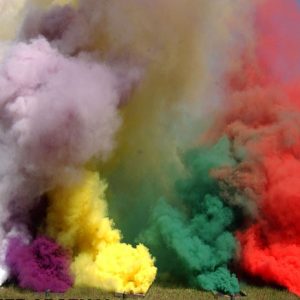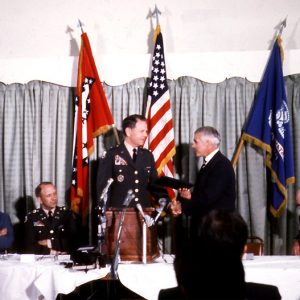calsfoundation@cals.org
Pine Bluff Arsenal
The Pine Bluff Arsenal was established on November 2, 1941, eight miles northeast of Pine Bluff (Jefferson County). Built on 14,944 acres and named the Chemical Warfare Arsenal (changed to Pine Bluff Arsenal in 1942), the facility produced millions of magnesium and thermite incendiary munitions for World War II and experimented with microbiological pathogens for potential germ warfare. During the war years, the arsenal employed 10,000 civilians and was an operational base to 350 military personnel. It long served as a repository for World War II stockpiles of aging chemical warfare agents and now includes hundreds of operational and production facilities, primarily for white and red phosphorus munitions and smoke munitions.
As World War II raged in Europe, and to prepare for America’s inevitable entry, the Army’s Chemical Warfare Service set in motion the construction of remotely located munitions plants. Aware of the economic benefits of such an installation on the state’s depressed economy, Congressman David D. Terry of Little Rock (Pulaski County) contacted the Army’s War Production Board and offered a remote area in southeast Arkansas—easily accessible by major river, rail, and road connection—for a munitions plant. To assure the Chemical Warfare Service that such a facility would be welcomed and supported, Terry solicited the help of Mayor Lawrence Blackwell of Pine Bluff. The mayor, who had lobbied federal agencies in Washington DC in search of defense contracts and federal industries, met with the Chemical Warfare Service’s commanding general and reiterated not only residents’ support but the city’s collaborative backing. In November 1941, with help from Pine Bluff’s elected officials and Arkansas Power and Light Company’s promised services, the U.S. Army bought land for the arsenal.
Construction costs were estimated at about $60 million. At the height of the war, the plant expanded from making magnesium and thermite incendiary munitions to a chemical warfare manufacturing facility as well, producing lethal gases and chemical compounds installed in artillery shells and specifically designed bombs. Fifteen civilian workers died in work-related accidents.
The facility grew with its expanded mission. More than 900 buildings and production facilities would consume 3.3 million square feet of space, forty-three miles of roads, and fourteen miles of track for diesel-electric locomotives pulling boxcars and flat cars of munitions.
In February 1942, the arsenal also became one of the nation’s storage depots for its expanding chemical stockpile munitions. These binary projectiles (lethal agents mixed after discharge of the projectile) were isolated in igloos near the northwest section of the facility.
The arsenal began producing lethal biological pathogens in 1953 at its Production Development Laboratories under the direction of the army’s chief microbiologist, William Capers Patrick. Patrick had perfected the production of anthrax spores that could be dispersed through the air. In 1956, he became the chief architect and production manager of such large-scale operations, called Project X1002, at the arsenal.
Among other factors, public outcry over the use of Agent Orange—a toxic herbicide used in the Vietnam War—caused President Richard Nixon to ban the production and use of biological weapons in 1969. Consequently, the biological weapons production facility at the arsenal was halted that year, but part of the complex, with a new mission, was moved a few miles north of the arsenal. Renamed the National Center for Toxicological Research (NCTR), this internationally recognized research center came under the control of the Department of Health and Human Services and a branch of the Food and Drug Administration (FDA).
The army’s Chemical and Biological Defense Command maintained 3,850 tons (12.3 percent of the nation’s chemical agent stockpile) of toxic nerve agents stored in protective containers and in aging World War II projectiles. The Chemical Agent Disposal Facility and its civilian contractor, the Washington Demilitarization Company, began on-site incineration of these agents in 2005. On November 16, 2010, arsenal officials announced that the last of the chemical agents stored there had been destroyed. The arsenal makes smoke, incendiary, and pyrotechnic devices and tests chemical defense clothing.
In May 2012, Vivione Biosciences announced its lease of 2,000 square feet of space at the arsenal for its work on rapid-B diagnostic technology. This technology was developed in partnership with the nearby NCTR.
For additional information:
Bolton, Charles S. “Turning Point: World War II and the Economic Development of Arkansas.” Arkansas Historical Quarterly 61 (Summer 2002): 124–149.
Miller, Judith, Stephen Engelberg, and William Broad. Germs: Biological Weapons and America’s Secret War. New York: Touchstone Books, 2002.
“Pine Bluff Celebrates 60th Anniversary of the Pine Bluff Arsenal.” Pine Bluff Commercial. July 4, 2002. Special Edition Supplement.
Russell E. Bearden
White Hall, Arkansas



 Pine Bluff Arsenal Assembly Line
Pine Bluff Arsenal Assembly Line  Pine Bluff Arsenal Smoke Grenades
Pine Bluff Arsenal Smoke Grenades  Pine Bluff Arsenal Transfer
Pine Bluff Arsenal Transfer 



To attribute Nixon’s action to cease bio-weapons production to criticism of Agent Orange is unsupportable in the facts. A newspaper columnist, John Anderson I believe, published a list of the agents being manufactured at Pine Bluff. By this time, the United States had already signed onto the international ban of biologicals, so that did put some pressure on the Nixon administration. Nevertheless, no general officer was really interested in the then-current technology of biological weapons. There was simply no evidence of efficacy or efficiency. The Department of Defense did not want to pay for maintaining the biological manufacturing facility or supporting any of the existing stockpile. Only a very minimal research organization has continued on the off chance that we may discover something that works someday.